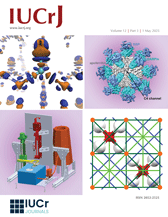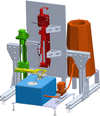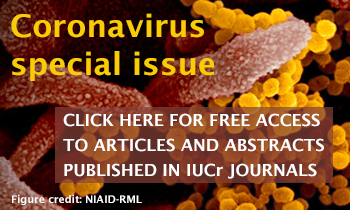issue contents
May 2025 issue

scientific commentaries
The design of crystalline solids relies on understanding and controlling intermolecular and intramolecular interactions. Through theoretical charge density analysis and database mining, Shukla et al. [(2025). IUCrJ, 12, 334–357] have found a new way of viewing supramolecular assembly through the lens of electrostatic complementarity.
Recent advances in protein design and protein structure prediction have questioned whether experimental structural biology still has a role to play in research today. The article by Panjikar and Weiss [(2025). IUCrJ, 12, 307–321] partially answers this question and alludes to a role still to be played by structural biology. Several properties of peptide bonds, likely important for function, are described that are absent in protein design and predicted protein structures, and that have largely been overlooked by the structural biology community.
Microcrystals are transforming structural biology by enabling high-resolution structures and time-resolved insights from samples once deemed too small. This commentary highlights recent advances in microfocus X-ray and MicroED methods, emphasizing their growing role as powerful and complementary tools in modern macromolecular crystallography.
feature articles
BIOLOGY | MEDICINE
Developments in macromolecular crystallography now allow the use of microcrystals for structural analysis through advanced beamlines and techniques such as microcrystal electron diffraction and room-temperature crystallography. This review addresses methods of matching microcrystal preparation and sample delivery. The use of microcrystals enhances the possibilities in fields such as time-resolved crystallography.
topical reviews
NEUTRON | SYNCHROTRON
A review of plane-wave coherent X-ray diffraction imaging in small-angle X-ray scattering geometry is presented, together with a discussion of the new opportunities offered by fourth-generation synchrotron sources.
research letters
NEUTRON | SYNCHROTRON
The crystal structure of cubo-ice (ice VII) has been established by single-crystal X-ray diffraction using both synchrotron and laboratory data collected at high pressure. X-ray diffraction data in both cases were refined with Hirshfeld atom refinement. Various structural models including those with `split' positions of atoms were refined.
research papers
MATERIALS | COMPUTATION
The development of quantum crystallography depends on the availability of reliable theoretical electron densities. This work demonstrates a non-negligible code dependence of these densities and warns against their blind use.
BIOLOGY | MEDICINE
High-resolution crystal structures reveal that peptide bonds in α-helices exhibit a slightly more pronounced enol-like character than those in β-strands. This can go as far as peptide oxygen atoms in protein structures being protonated.
MATERIALS | COMPUTATION
This work presents a new iterative refinement method, comparable to Hirshfeld atom refinement, using the Hansen–Coppens multipole model charge density description to obtain accurate atomic coordinates and atomic displacements based on CRYSTAL17 periodic boundary calculations. The refinement, performed using the Python code ReCrystal, allows the user to explore the full periodic charge density in the crystalline solid state for charge density analysis of weak interactions.
CHEMISTRY | CRYSTENG
Download citation


Download citation


This study establishes that hydrogen-, halogen- and chalcogen-bonding intermolecular and non-covalent intramolecular interactions are driven by a face-to-face orientation of electrophilic (charge-depleted) and nucleophilic (charge-concentrated) regions, which is the origin of the specific geometries found in synthons and supramolecular motifs.
CCDC reference: 2424586
BIOLOGY | MEDICINE
Varied pulse-duration and pulse-intensity serial femtosecond crystallography data do not show significant signs of radiation damage under typical experimental conditions.
PDB references: thaumatin, 7.9 fs, 10 µJ, 9epe; 7.9 fs, 50 µJ, 9eqr; 7.9 fs, 100 µJ, 9eqs; 23.8 fs, 10 µJ, 9eqt; 23.8 fs, 100 µJ, 9equ; 41.3 fs, 10 µJ, 9eqv; 41.3 fs, 50 µJ, 9eqx; 41.3 fs, 100 µJ, 9eqy; 52.7 fs, 10 µJ, 9eqz; 52.7 fs, 50 µJ, 9er0; 52.7 fs ,100 µJ, 9er1; DtpAa, 7.9 fs, 10 µJ, 9epd; 23.8 fs, 10 µJ, 9epg; 23.8 fs, 100 µJ, 9epk; 41.3 fs, 10 µJ, 9epj; 52.7 fs, 10 µJ, 9epi; 52.7 fs, 100 µJ, 9eph
BIOLOGY | MEDICINE
Download citation


Download citation


Methods and instrumentation for reaction initiation via mixing followed by rapid cooling allow sample-efficient time-resolved crystallographic studies with sub-10 ms time resolution. The instrumentation is robust, amenable to diverse samples, cost-effective and enables the remote collection of time-resolved X-ray data using standard sample supports and high-throughput cryocrystallography beamlines.
PDB references: lysozyme–NAG1, 0 ms, 9mp3; 8 ms, 9mp4; 50 ms, 9mp5; 150 ms, 9mp6; 300 ms, 9mp7; 750 ms, 9mp8; 1000 ms, 9mp9; 2000 ms, 9mpa
CHEMISTRY | CRYSTENG
Download citation


Download citation


The temperature dependence of accurate structure factors of L-alanine and taurine was measured at the SPring-8 BL02B1 beamline. The quality of the structure factors is evaluated by charge density and quantum crystallographic studies. The effects of small amounts of twinning on the charge density study for taurine are also described.
CRYO | EM
This study introduces a modular scaffold strategy utilizing designed ankyrin-repeat proteins (DARPins) and a symmetric apoferritin base to overcome size limitations in single-particle cryo-EM, enabling near-atomic-resolution structural determination of medium-sized proteins like GFP and MBP. The high-symmetry, near-spherical scaffold not only resolves the common preferred-orientation challenges in single-particle cryo-EM but also reduces data-processing demands, offering a versatile platform for structural analysis of diverse proteins.
CHEMISTRY | CRYSTENG
Download citation


Download citation


This study reveals how additives and microwave radiation influence the crystallization of new tyramine polymorphs and their cocrystallization with barbital. The findings provide insights into polymorph stability and offer potential applications in molecular encapsulation and optical materials.


 journal menu
journal menu




 access
access



























